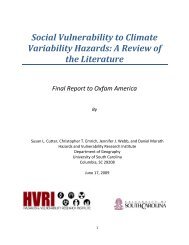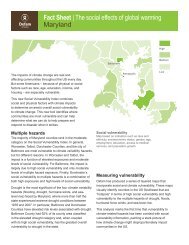Poverty Footprint Study on how the Coca Cola - Oxfam America
Poverty Footprint Study on how the Coca Cola - Oxfam America
Poverty Footprint Study on how the Coca Cola - Oxfam America
Create successful ePaper yourself
Turn your PDF publications into a flip-book with our unique Google optimized e-Paper software.
10<br />
Value chain: Security<br />
and stability<br />
Headlines<br />
Sugarcane harvesters face potential risks to <strong>the</strong>ir<br />
health and safety.<br />
Endemic crime in El Salvador affects people throughout<br />
<strong>the</strong> value chain. Independent truck drivers in Zambia<br />
face potential safety risks posed by working extended<br />
hours <strong>on</strong> hazardous roads.<br />
58 Exploring <strong>the</strong> links between internati<strong>on</strong>al business and poverty reducti<strong>on</strong><br />
A lack of security can severely hamper development.<br />
Protecti<strong>on</strong> from a variety of insecurities—ec<strong>on</strong>omic,<br />
medical, nutriti<strong>on</strong>al or envir<strong>on</strong>mental—is essential<br />
to <strong>the</strong> well-being of people living in poverty. Secure<br />
people enjoy freedom of movement, freedom of<br />
speech and access to essential resources to help<br />
<strong>the</strong>m endure unexpected threats to <strong>the</strong>ir livelihoods,<br />
which can include serious illness, unemployment<br />
and natural disasters. Secure workers can practice<br />
<strong>the</strong>ir livelihoods in safety, free from hazardous<br />
occupati<strong>on</strong>al risks, poor working c<strong>on</strong>diti<strong>on</strong>s<br />
and crime.<br />
Dangers of sugarcane harvesting<br />
Harvesting sugarcane is a rigorous physical activity<br />
requiring <strong>the</strong> use of a machete to cut large stalks of<br />
cane. Ninety percent or 18 out of <strong>the</strong> 20 sugarcane<br />
workers we interviewed in El Salvador, reported<br />
facing occupati<strong>on</strong>al safety risks, including injuries,<br />
burns and pois<strong>on</strong>ing <strong>on</strong> a regular basis. Five, or a<br />
quarter, have suffered work-related accidents and<br />
frequently do not have adequate safety gear, leaving<br />
<strong>the</strong>m vulnerable to hazards. Despite <strong>the</strong>se risks,<br />
when asked about what would improve <strong>the</strong>ir working<br />
c<strong>on</strong>diti<strong>on</strong>s most, 12 or 60 percent indicated better<br />
salaries while <strong>on</strong>ly four, or 20 percent, indicated<br />
better access to medical services and basic benefits.




